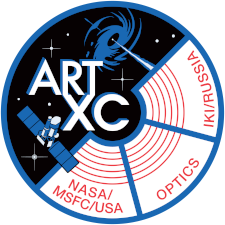About
ART-XC is a focusing hard X-ray telescope operating over
the energy range of 4−30 keV, with an angular resolution of less than 1
arcminute on-axis, a field of view of ~0.3 square degree and an energy
resolution of about 9% at 14 keV. The ART-XC primary mission will be to
perform a four-year all-sky survey simultaneously with the other SRG
instrument, eROSITA, followed by three years of pointed observations.
All-sky survey

During first four years, ART-XC survey will scan the entire sky every 6 months. With a total effective area of 455 square centimeter (at 8 keV), after the 4-year survey, the ART-XC survey will reach 10^-12 erg/s/cm^2 flux limit in the 5-11 keV band.
The all-sky survey design also includes two "deep" regions in the north and south ecliptic poles, due to the telescope's orbit and the surrey's scan pattern. At these regions, the survey sensitivity will be at least 4 times deeper over 400 square degrees.
Compared to existing "hard" X-ray surveys such as the "wide and shallow" Swift/BAT all-sky survey, and "narrow but deep" NuSTAR extragalactic surveys, ART-XC surveys will occupy the Luminosity-redshift parameter space that has yet to be explored (see the figure shown here).
Scientific Topcis
The hard X-ray energy range covered by ART-XC is primed for studying a broad range of high-energy sources, including
- Galaxy Evolution and Super Massive Black holes
An established yet puzzling fact in galaxy evolution is the existence of "supermassive" black holes in the hearts of distant galaxies, and the tight connection between these black holes and the galaxy bulge properties despite the vast difference in their physical sizes. The completed ART-XC all-sky survey will detect high-energy X-ray photons from over 20,000 actively accreting supermassive black holes in the hard X-ray.
- The Death of Stars
ART-XC is also capable of detecting X-ray photons powered by stellar processes, particularly from those emitted during the last stage of a star's life cycle. The potential scientific topics of ART-XC include the detection of supernovae that occurs during the death of massive stars, studying the high-energy X-ray photons of the dense remnants of supernovae, including neutron stars and X-ray black hole binaries. In addition to the massive stars, ART-XC will also detect high-energy X-ray photons from less-massive objects such as novae and/or cataclysmic variables.
- Variability and Transient studies
During the planned 4-year survey, ART-XC will scan the entire sky every 6-month. This will enable an unprecedented, all-sky variability and transient studies with a focusing hard X-ray telescope. Moreover, the ecliptic pole regions will have a substantially higher cadence (some of the regions will have more than 200 visits by ART-XC) due to the survey design.

 During first four years, ART-XC survey will scan the entire sky every 6 months. With a total effective area of 455 square centimeter (at 8 keV), after the 4-year survey, the ART-XC survey will reach 10^-12 erg/s/cm^2 flux limit in the 5-11 keV band.
The all-sky survey design also includes two "deep" regions in the north and south ecliptic poles, due to the telescope's orbit and the surrey's scan pattern. At these regions, the survey sensitivity will be at least 4 times deeper over 400 square degrees.
Compared to existing "hard" X-ray surveys such as the "wide and shallow" Swift/BAT all-sky survey, and "narrow but deep" NuSTAR extragalactic surveys, ART-XC surveys will occupy the Luminosity-redshift parameter space that has yet to be explored (see the figure shown here).
During first four years, ART-XC survey will scan the entire sky every 6 months. With a total effective area of 455 square centimeter (at 8 keV), after the 4-year survey, the ART-XC survey will reach 10^-12 erg/s/cm^2 flux limit in the 5-11 keV band.
The all-sky survey design also includes two "deep" regions in the north and south ecliptic poles, due to the telescope's orbit and the surrey's scan pattern. At these regions, the survey sensitivity will be at least 4 times deeper over 400 square degrees.
Compared to existing "hard" X-ray surveys such as the "wide and shallow" Swift/BAT all-sky survey, and "narrow but deep" NuSTAR extragalactic surveys, ART-XC surveys will occupy the Luminosity-redshift parameter space that has yet to be explored (see the figure shown here).